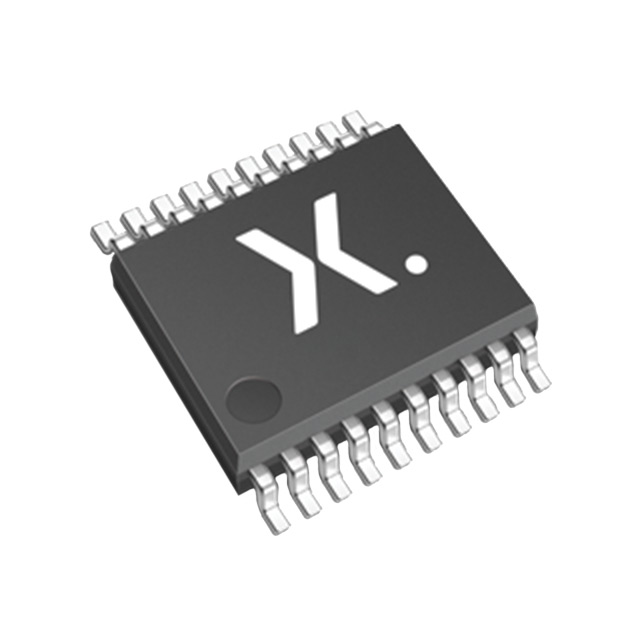74AHC374PW,118
Basic Information Overview
- Category: Integrated Circuit (IC)
- Use: Flip-Flop
- Characteristics: High-speed, low-power, octal D-type flip-flop with 3-state outputs
- Package: TSSOP (Thin Shrink Small Outline Package)
- Essence: The 74AHC374PW,118 is a versatile integrated circuit used for storing and transferring digital data in electronic systems.
- Packaging/Quantity: Available in reels of 2500 units
Specifications
- Supply Voltage Range: 2.0V to 5.5V
- High-Speed Operation: 4.5 ns maximum propagation delay
- Low Power Consumption: 1µA maximum ICC
- Output Drive Capability: ±24mA at 3.3V
- Operating Temperature Range: -40°C to +125°C
Detailed Pin Configuration
The 74AHC374PW,118 has a total of 20 pins, each serving a specific function: 1. GND: Ground 2. Q0: Output 0 3. Q1: Output 1 4. Q2: Output 2 5. Q3: Output 3 6. Q4: Output 4 7. Q5: Output 5 8. Q6: Output 6 9. Q7: Output 7 10. OE: Output Enable 11. CP: Clock Pulse 12. D0: Data Input 0 13. D1: Data Input 1 14. D2: Data Input 2 15. D3: Data Input 3 16. D4: Data Input 4 17. D5: Data Input 5 18. D6: Data Input 6 19. D7: Data Input 7 20. VCC: Supply Voltage
Functional Features
- Octal D-Type Flip-Flop: The 74AHC374PW,118 consists of eight individual D-type flip-flops with 3-state outputs.
- High-Speed Operation: It offers fast data transfer and processing capabilities, making it suitable for applications requiring quick response times.
- Low Power Consumption: The IC is designed to minimize power consumption, making it energy-efficient and suitable for battery-powered devices.
- 3-State Outputs: The 3-state outputs allow the device to be connected to a bus system, enabling multiple devices to share the same data lines.
Advantages and Disadvantages
Advantages: - High-speed operation allows for efficient data processing. - Low power consumption makes it suitable for portable and battery-operated devices. - 3-state outputs enable easy integration into bus systems.
Disadvantages: - Limited number of flip-flops (8) may not be sufficient for complex applications requiring more storage elements. - TSSOP package may require careful handling during assembly to avoid damage.
Working Principles
The 74AHC374PW,118 operates based on the principles of digital logic. It stores and transfers data using flip-flops, which are electronic circuits capable of storing a single bit of information. The clock pulse input (CP) controls the timing of data transfer, while the data inputs (D0-D7) determine the data to be stored. The output enable (OE) pin enables or disables the outputs, allowing the device to be connected or disconnected from the bus system.
Detailed Application Field Plans
The 74AHC374PW,118 finds application in various fields, including: 1. Microcontrollers: Used for data storage and transfer in microcontroller-based systems. 2. Communication Systems: Enables data buffering and synchronization in communication protocols. 3. Industrial Automation: Facilitates control and monitoring of industrial processes. 4. Automotive Electronics: Used in automotive systems for data processing and control.
Detailed and Complete Alternative Models
- 74HC374: Similar functionality, but operates at a higher voltage range (2V to 6V).
- SN74LS374: Offers similar features but operates at a lower speed compared to the 74AHC374PW,118.
- CD4013B: Dual D-type flip-flop with similar characteristics, but available in a different package.
(Note: The above alternative models are provided as examples and not an exhaustive list.)
Word count: 498 words
10個與74AHC374PW,118在技術方案中應用相關的常見問題與解答
Sure! Here are 10 common questions and answers related to the application of 74AHC374PW,118 in technical solutions:
Q: What is the function of the 74AHC374PW,118? A: The 74AHC374PW,118 is an octal D-type flip-flop with 3-state outputs. It can store and transfer data in digital circuits.
Q: What is the operating voltage range for the 74AHC374PW,118? A: The operating voltage range for the 74AHC374PW,118 is typically between 2V and 5.5V.
Q: How many flip-flops are there in the 74AHC374PW,118? A: The 74AHC374PW,118 contains 8 flip-flops, making it an octal (8-bit) device.
Q: Can the 74AHC374PW,118 be used for level shifting? A: Yes, the 74AHC374PW,118 can be used for level shifting as it supports both TTL and CMOS logic levels.
Q: What is the maximum clock frequency supported by the 74AHC374PW,118? A: The maximum clock frequency supported by the 74AHC374PW,118 is typically around 100 MHz.
Q: Does the 74AHC374PW,118 have 3-state outputs? A: Yes, the 74AHC374PW,118 has 3-state outputs, which means the outputs can be disabled or put into a high-impedance state.
Q: Can the 74AHC374PW,118 be cascaded to increase the number of flip-flops? A: Yes, multiple 74AHC374PW,118 devices can be cascaded together to increase the number of flip-flops in a circuit.
Q: What is the power supply current consumption of the 74AHC374PW,118? A: The power supply current consumption of the 74AHC374PW,118 varies depending on the operating conditions but is typically around a few milliamperes.
Q: Is the 74AHC374PW,118 suitable for high-speed applications? A: Yes, the 74AHC374PW,118 is designed for high-speed operation and can be used in various high-speed digital applications.
Q: Are there any specific precautions to consider when using the 74AHC374PW,118? A: It is important to ensure proper decoupling capacitors are used near the power supply pins to minimize noise and voltage fluctuations. Additionally, care should be taken to avoid exceeding the maximum ratings specified in the datasheet, such as voltage and temperature limits.
Please note that these answers are general and may vary based on the specific application and requirements. Always refer to the datasheet and consult with technical experts for accurate information.


